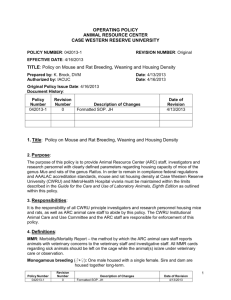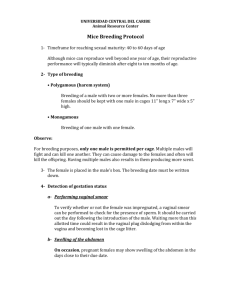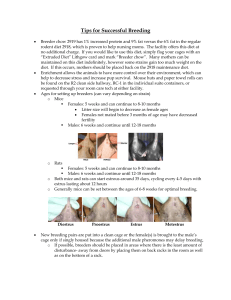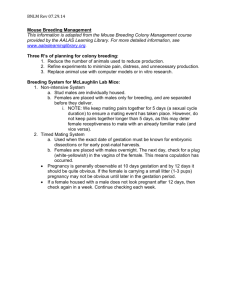Breeding of Mice - Thomas Jefferson University
advertisement
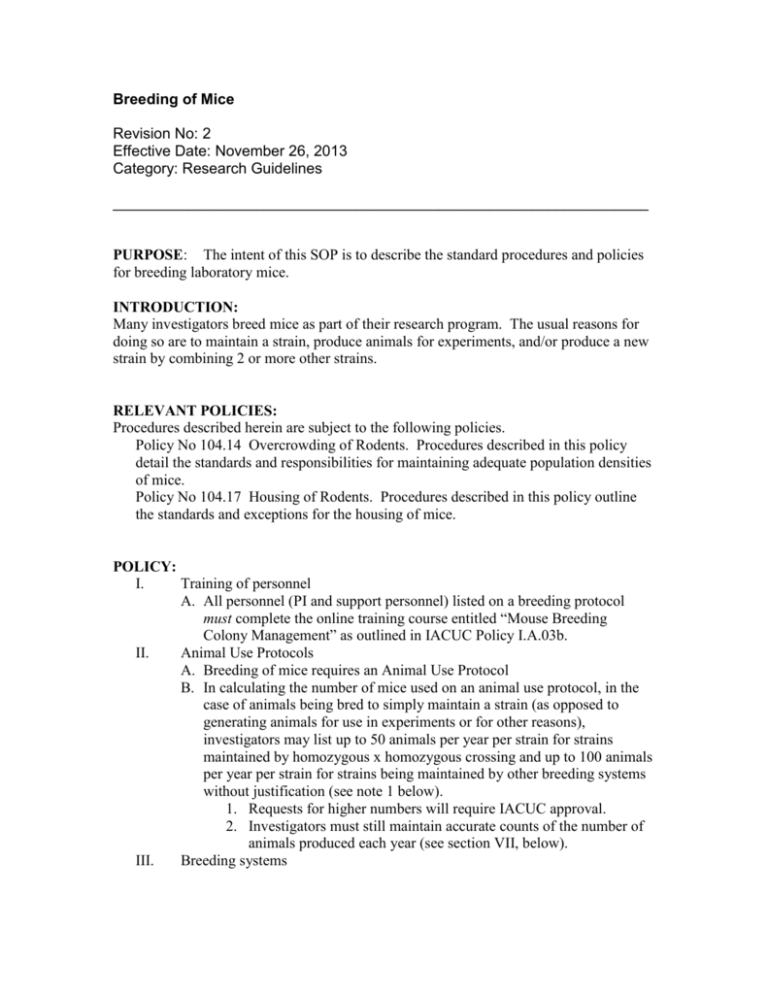
Breeding of Mice Revision No: 2 Effective Date: November 26, 2013 Category: Research Guidelines ________________________________________________________________ PURPOSE: The intent of this SOP is to describe the standard procedures and policies for breeding laboratory mice. INTRODUCTION: Many investigators breed mice as part of their research program. The usual reasons for doing so are to maintain a strain, produce animals for experiments, and/or produce a new strain by combining 2 or more other strains. RELEVANT POLICIES: Procedures described herein are subject to the following policies. Policy No 104.14 Overcrowding of Rodents. Procedures described in this policy detail the standards and responsibilities for maintaining adequate population densities of mice. Policy No 104.17 Housing of Rodents. Procedures described in this policy outline the standards and exceptions for the housing of mice. POLICY: I. Training of personnel A. All personnel (PI and support personnel) listed on a breeding protocol must complete the online training course entitled “Mouse Breeding Colony Management” as outlined in IACUC Policy I.A.03b. II. Animal Use Protocols A. Breeding of mice requires an Animal Use Protocol B. In calculating the number of mice used on an animal use protocol, in the case of animals being bred to simply maintain a strain (as opposed to generating animals for use in experiments or for other reasons), investigators may list up to 50 animals per year per strain for strains maintained by homozygous x homozygous crossing and up to 100 animals per year per strain for strains being maintained by other breeding systems without justification (see note 1 below). 1. Requests for higher numbers will require IACUC approval. 2. Investigators must still maintain accurate counts of the number of animals produced each year (see section VII, below). III. Breeding systems A. All animal use protocols (AUPs) utilizing breeding of mice must identify the breeding system(s) used for animals in that protocol (see below for description). The possible choices are i) continuous breeding, ii) sequential breeding, or iii) other. B. Investigators who identify the breeding system used as “other” must describe this system in detail in the AUP. This category includes any deviation from the continuous and sequential systems described below. Use of this method is subject to the IACUC review and approval process. C. The Guide for the Care and Use of Laboratory Animals stipulates the minimum housing space for mice. As such, only one female plus litter can be housed in the standard mouse box. If there is a valid scientific or veterinary reason for housing more than one female plus litter in a cage, a justification for an exemption to The Guide must be submitted to the IACUC for review. D. Description of breeding systems 1. Continuous Breeding a. Introduction i. In continuous breeding, dams and sires remain in the same cage continuously. This method provides the highest productivity for any single breeding unit, as females are impregnated at the highest possible rate. It is typical that the females will breed immediately after giving birth. Because of this, the next litter is born about the time that the preceding litter is ready for weaning. It is imperative that animals be monitored closely so that two litters from the same dam are not found in the same cage. ii. A breeding unit (a cage of breeders) can be set up with a single male and one female or two females with IACUC approval. The pregnant females must be separated prior to parturition. b. Method i. A single male is housed with either 1. A single female (pair mating) 2. A pair of females (trio mating), requires IACUC approval as described in section V “Housing of Pregnant and Lactating Females” ii. Pups must be weaned before the next litter is born. In the event that a new litter appears in the cage, the preceding litter must be weaned immediately. 2. Sequential Breeding a. Introduction i. In sequential breeding, dams are placed into cages with males and removed after a set period of time or when visibly pregnant. In practice the most useful grouping is 2 females with a stud. This is because males, particularly those of inbred strains, are typically capable of impregnating only a few females per week due to sperm depletion. This method allows one to maintain a limited number of stud cages while maximizing production by rotating pairs of females through the stud cages on a weekly basis. b. Method i. A single male is housed with either 1. A single female (pair housed) 2. A pair of females (trio mating) ii. Females are removed from the breeding cage when they are either obviously pregnant or they have resided with the males for more than 3 weeks iii. NOTE: If a female with litter is housed without a male, DO NOT place a male in the cage with her before the litter is weaned as he, or she, is more likely to destroy the existing litter. IV. V. VI. VII. Housing of males A. Stud males may be single-housed to prevent fighting. Single housing requires scientific justification and approval of the IACUC. Singly housed mice must be offered some form of environmental enrichment. Housing of pregnant and lactating females A. Pregnant or lactating females are housed singly or with another pregnant female only if an exemption has been approved by the IACUC. If an exemption is approved by the IACUC, pair-housed females may assist each other in raising their litters. B. Cages with litters of pups should be marked with the date of birth of the litter. Weaning of pups A. Pups should be weaned at 3 weeks of age. The earliest recommended weaning is 18 days after birth. All pups must be weaned before they reach sexual maturity. B. In the case of continuous breeding using 1 female per male, pups from the first litter must be weaned immediately if the dam gives birth to the subsequent litter in the same cage C. Weaned pups must be separated by sex and housed so as to prevent overcrowding, as per Policy No 104.14, “Overcrowding of Rodents.” Record Keeping A. All animals used and produced in a breeding protocol count towards animal usage numbers. It is recommended that pups be counted and recorded 48 – 72 hours after birth. All offspring must be counted the first time they are manipulated for any reason, such as genotyping, use in VIII. IX. experiments, culling or weaning. All offspring are counted, regardless of genotype. B. Investigators must keep accurate logs of animal breeding, including (but not limited to): 1. Number of mice born 2. Date of Birth 3. Strain 4. Protocol # Exceptions to the requirements outlined in this policy will require scientific justification and approval of the IACUC before implementation. Compliance A. Failure to comply with the requirements of this policy may result in the suspension or termination of the breeding protocol. Notes 1. Animal number justifications in IIB above are based on the recommendations outlined the Jackson Laboratory Resource Manual, “Breeding Strategies for Maintaining Colonies of Laboratory Mice”. They recommend maintaining a minimum of 6 breeder pairs representing different generations in a colony, and replacing breeders at 2 – 8 months of age. If breeders are replaced every year, then at any one time there will be 6 breeder pairs minimum. If each produces 8 pups, this will be 48 animals produced per year. We round this up to 50 animals per year for homozygous breeder pairs, and 100 animals per year for other mating schemes. Signature: Reviewed by: ___________________________________________________________ Name Title Date Approved by: ___________________________________________________________ Name Title Date
